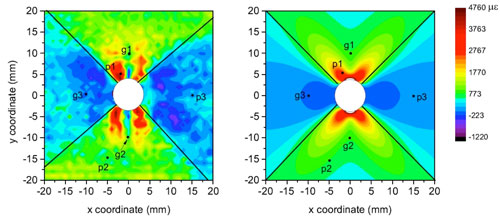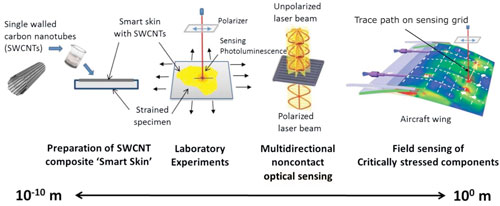| Nov 15, 2018 | |
'Smart skin' simplifies spotting strain in structures(Nanowerk News) Thanks to one peculiar characteristic of carbon nanotubes, engineers will soon be able to measure the accumulated strain in an airplane, a bridge or a pipeline – or just about anything – over the entire surface or down to microscopic levels. |
|
| They’ll do so by shining a light onto structures coated with a two-layer nanotube film and protective polymer. Strain in the surface will show up as changes in the wavelengths of near-infrared light emitted from the film and captured by a miniaturized hand-held reader. The results will show engineers and maintenance crews whether structures like bridges or aircraft have been deformed by stress-inducing events or regular wear and tear. | |
 |
|
| Experimental (left) and simulated (right) strain maps around a hole through an aluminum bar show that nanotube-infused "smart skin" developed at Rice University can effectively assess strain in materials. The technique can be used for aircraft, spacecraft and critical infrastructures in which mechanical strain needs to be monitored. (Credit: Satish Nagarajaiah Group/Weisman Research Group/Rice University) (click on image to enlarge) | |
| Like a white shirt under an ultraviolet light, single-wall carbon nanotubes fluoresce, a property discovered in 2002 in the lab of Rice chemist Bruce Weisman. In a basic research project a few years later, the group showed that stretching a nanotube changes the color of its fluorescence. | |
| When Weisman’s results came to the attention of Rice civil and environmental engineer Satish Nagarajaiah — who had been working independently on similar ideas using Raman spectroscopy, but at the macro scale, since 2003 — he suggested collaborating to turn that scientific phenomenon into a useful technology for strain sensing. | |
| Now, Nagarajaiah and Weisman and have published a pair of important papers about their “smart skin” project. The first appears in Structural Control & Health Monitoring ("Dual-layer nanotube-based smart skin for enhanced noncontact strain sensing"), and introduces the latest iteration of the technology they first revealed in 2012 ("Nano-infused paint can detect strain"). | |
| It describes a method of depositing the microscopic nanotube-sensing film separately from a protective top layer. Color changes in the nanotube emission indicate the amount of strain in the underlying structure. The researchers say it enables two-dimensional mapping of accumulated strain that can’t be achieved by any other non-contact method. | |
| The second paper, in the Journal of Structural Engineering ("Noncontact Strain Mapping Using Laser-Induced Fluorescence from Nanotube-Based Smart Skin"), details the results of testing smart skin on metal specimens with irregularities where stress and strain are often concentrated. | |
| “The project started out as pure science about nanotube spectroscopy, and led to the proof-of-principle collaborative work that showed we could measure the strain of the underlying substrate by checking the spectrum of the film in one place,” Weisman said. “That suggested the method could be expanded to measure whole surfaces. What we’ve shown now is a lot closer to that practical application.” | |
| Since the initial report, the researchers have refined the composition and preparation of the film and its airbrush-style application, and also developed scanner devices that automatically capture data from multiple programmed points. Unlike conventional sensors that only measure strain at one point along one axis, the smart film can be selectively probed to reveal strain in any direction and location. | |
 |
|
| "Smart skin" able to detect strain in materials, invented at Rice University, starts with carbon nanotubes and their unique ability to change their fluorescence under stress. When attached to a surface, they can be used to monitor stress over time through spectroscopy. (Imgae: Satish Nagarajaiah Group/Weisman Research Group/Rice University) (click on image to enlarge) | |
| The two-layer film is only a few microns thick, a fraction of the width of a human hair, and barely visible on a transparent surface. “In our initial films, the nanotube sensors were mixed into the polymer,” Nagarajaiah said. “Now that we’ve separated the sensing and the protective layers, the nanotube emission is clearer and we can scan at a much higher resolution. That lets us capture significant amounts of data rather quickly.” | |
| The researchers tested smart skin on aluminum bars under tension with either a hole or a notch to represent the places where strain tends to build. Measuring these potential weak spots in their unstressed state and then again after applying stress showed dramatic changes in strain patterns pieced together from point-by-point surface mapping. | |
| “We know where the high-stress regions of the structure are, the potential points of failure,” Nagarajaiah said. “We can coat those regions with the film and scan them in the healthy state, and then after an event like an earthquake, go back and re-scan to see whether the strain distribution has changed and the structure is at risk.” | |
| In their tests, the researchers said the measured results were a close match to strain patterns obtained through advanced computational simulations. Readings from the smart skin allowed them to quickly spot distinctive patterns near the high-stress regions, Nagarajaiah said. They were also able to see clear boundaries between regions of tensile and compressive strain. | |
| “We measured points 1 millimeter apart, but we can go 20 times smaller when necessary without sacrificing strain sensitivity,” Weisman said. That’s a leap over standard strain sensors, which only provide readings averaged over several millimeters, he said. | |
| The researchers see their technology making initial inroads in niche applications, like testing turbines in jet engines or structural elements in their development stages. “It’s not going to replace all existing technologies for strain measurement right away,” Weisman said. “Technologies tend to be very entrenched and have a lot of inertia. | |
| “But it has advantages that will prove useful when other methods can’t do the job,” he said. “I expect it will find use in engineering research applications, and in the design and testing of structures before they are deployed in the field.” | |
| With their smart skin refined, the researchers are working toward developing the next generation of the strain reader, a camera-like device that can capture strain patterns over a large surface all at once. |
| Source:Rice University | |
|
Subscribe to a free copy of one of our daily Nanowerk Newsletter Email Digests with a compilation of all of the day's news. |
